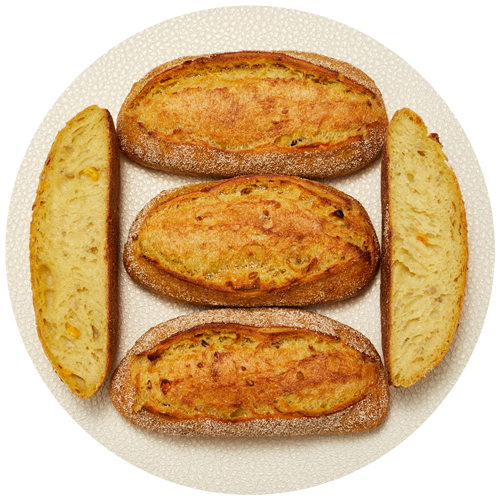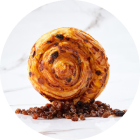Frequently Asked Questions
Since the Middle Ages, bread has been the staple of the French diet. Dense and hard, it was often dipped in soup. It wasn’t until Parmentier and his research on potatoes and bread that production improved. In 1778, he wrote a seminal work, Le Parfait Boulanger, and with other scholars, founded the first free bakery school in Paris. Some believe that the lack of bread was a driving force behind the French Revolution. When the revolutionaries stormed the Bastille in 1789, they expected to find a stockpile of wheat there. Later, when symbols for the Republic were needed, the sheaf, the ear of wheat, and the sower’s gesture naturally became emblematic.
In the early 19th century, the first bakery-pastry shops opened in Paris. Amidst the gilding and glass paintings, they started the trend of English bread (made with beer yeast), Provençal bread, and Viennese bread. Wheat bread (white) gradually replaced whole wheat bread (black), which had been the most common until then. The latter remained the staple of the poor and rural areas until 1950. Bread became a mere accompaniment in the mid-20th century. At that time, consumption was 325 grams per person per day, almost three times less than in 1900. New intensive kneading methods gave bread unprecedented volume and whiteness, to the detriment of its texture and flavor. Industrial bakery further degraded it. Both the public and nutritionists turned away from it. Nevertheless, bread remained ubiquitous in everyday language with numerous colorful expressions: “As long as a day without bread,” “I don’t eat that kind of bread,” “I’ve eaten more than one loaf” (meaning traveled a lot)…
Initiated in the 1970s, the return of specialty breads and rustic breads was confirmed in the 1980s when the entire artisan sector rallied. The bread machine entered households. Consumption finally began to rise again in 2002. Bread once again became a daily pleasure, a flagship of the French art of living. Eric Kayser bakeries are among the key players in this revival.
Sourdough is a symbiotic culture of yeast and lactic bacteria growing in a mixture of flour and water. It is used to make sourdough bread, to which it gives a specific taste, different from that of yeast bread.
For a long time, the addition of sourdough was the only way to make bread rise. It is very difficult to date the discovery of leaven, but the earliest representations of it date back to the Old Egyptian Empire. Depending on the version, leaven may have been discovered by the Babylonians or the Hebrews. But the most frequently cited origin is that of Egypt: a person delayed cooking his cereal dough, and this, under the effect of fermentation, began to swell, thus creating the first leavened bread. The Egyptians, and before them the Sumerians, mastered fermentation: they made both beer and bread.
Sourdough bread is nutritionally more interesting than bread made with chemical yeast. In fact, sourdough promotes better mineral assimilation and greater breakdown of gluten, which is sometimes responsible for allergies. Sourdough bread keeps longer than yeast-raised bread, because the acidity provided by sourdough slows down the “retrogradation” of starch. Through this spontaneous phenomenon, the starch tends to return to its original structure, promoting the exchange of moisture between the bread and the surrounding environment. Retrogradation is largely responsible for staling. The baker’s art lies in using techniques that slow down this natural mechanism.
On average, sourdough remains active for 3 days after refreshing. So, every 3 days, you’ll need to refresh the leaven by adding 50% of its weight in water and flour. For example, if you have 300g of sourdough left, add 75g of flour and 75g of water. Remember that sourdough is alive and that you need to feed it to keep it going. If you go several days without making bread, or if the ambient temperature is high, close the jar tightly and put it in the fridge. It will keep for a few weeks. Depending on the frequency of your kneading, you can modify the initial quantity of sourdough.
No, quite the contrary! Our aim is to create flexible, creative structures on a human scale, with artisanal values at the forefront. Wherever they are in the world, our bakeries have a soul. Far from forming a chain, each one reflects its neighborhood, its town and its country. For each new bakery, Eric Kayser creates a bread: the first was the Monge baguette at 8 rue Monge, followed by the Assam loaf, a large 400-gram loaf reminiscent of the good bread of yesteryear. For the bakery at 85 boulevard Malesherbes, he developed a highly honeycombed baguette that is not shaped: the Malesherbes baguette. Other examples? The bûchette éternelle for the 19 avenue des ternes bakery, very rich in trace elements; the Odéon santé bread, a sandwich loaf with cereals; the bon BAC, a large square loaf with Guérande salt sold at 18 rue du Bac… So each bakery writes a chapter in our creative tradition.
Visit our “Join us” pages to discover the spirit of Maison Kayser, our professions and apply online











